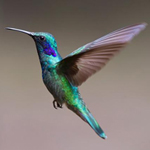National Hummingbird Day Date in the current year: September 5, 2026
 On the first Saturday of September, we celebrate a holiday dedicated to small birds with a big attitude. National Hummingbird Day was created to raise awareness of the smallest birds in the world.
On the first Saturday of September, we celebrate a holiday dedicated to small birds with a big attitude. National Hummingbird Day was created to raise awareness of the smallest birds in the world.Hummingbirds are small birds that comprise the family Trochilidae. According to the International Ornithological Committee, there are 362 hummingbird species, two of which are extinct. All hummingbirds are native to the Americas. They occur throughout North and South America, from Alaska in the north to Tierra del Fuego in the south, but most hummingbird species live in the tropics.
Hummingbirds are widely regarded as the smallest birds in the world. Most hummingbird species are 3–5 inches long. The smallest hummingbird species, as well as the world’s smallest extant bird, is the bee hummingbird. Bee hummingbirds are just a little over 2 inches long. The giant hummingbird is the largest hummingbird species, just like the name suggests. Its has a length of approximately 9 inches.
Hummingbirds received their English name because of the humming sound their beating wings make when they are flying or hovering in the air. No other flying animal makes a similar sound. Many languages have adopted the Spanish name for a hummingbird, colibrí. Its origin is somewhat ambiguous; the most popular version claims that it was borrowed into Spanish from an extinct indigenous Caribbean language.
In order for their wings to beat so rapidly, hummingbirds have evolved to have the highest metabolism rate of all animals, except for insects. At night or at any time when food is scarce, hummingbirds enter a deep-sleep state called torpor to conserve energy. Torpor is similar to hibernation, but the former is short-term and the latter is long-term.
Hummingbirds feed on small insects and nectar. Nectar is the source of sugars (sucrose, glucose and fructose) that give these birds the energy they need due to their high metabolism, as well as the source of water, and insects are the source of protein and other nutrients that nectar doesn’t have. Hummingbirds are able to convert sugars into energy with a 97% efficiency rate. Due to feeding on nectar, these birds are important pollinators.
Since most hummingbird species are tropical, they are usually brightly colored. The bright plumage of male hummingbirds plays a role in courtship and territorial competitions. The throat and face fathers of hummingbirds are iridescen, which means that their color changes depending on the viewing angle. This effect results from a combination of pigmentation and prism-shaped cells in the top layer of feathers that reflect sunlight at different angles.
The origin of National Hummingbird Day is unclear, but it doesn’t mean that the holiday isn’t worth your attention. Celebrate it by reading a book or watching a documentary about hummingbirds, checking out a hummingbird exhibit at a zoo near you, donating to a hummingbird conservation organization, and raising the profile of the holiday on social media with the hashtag #NationalHummingBirdDay.
- Category
- Ecological Observances, Unofficial Holidays
- Country
- USA
- Tags
- National Hummingbird Day, environmental observances, unofficial holidays, holidays in the US, hummingbirds